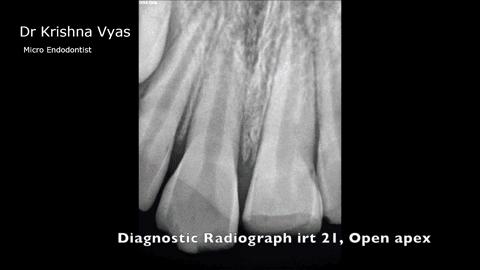| Pulpal necrosis in permanent teeth that have not completed their root development may lead to short root length, thin root walls and inadequate crown-root ratio, compromising their long term prognosis. |
| The apex is wide open… |
| A necrotic tooth with an immature root and open apex is of particular challenge to the clinician in preserving the tooth and obtaining closure of the root and maintaining a sterile root environment. Apexcification with CaOH has been the classical approach in treatment of these scenarios. With it’s origins initially being introduced by Hermann in the 1920’s and popularized by Frank in 1966, Calcium Hydroxide has the extraordinary ability to hydrolyze lipid moiety of bacterial lipopolysaccharides resulting in the biological inactivation of lipopolysaccharide and subsequent cessation of lipopolysaccharide induced inflammation in the periradicular tissue. This ability to obtain sterile environment, control inflammation as well as gain apical closure by formation of calcified barrier, has made CaOH a popular option for apexification. However, the treated teeth with calcium hydroxide require a prolonged follow up period and regiment that often entails a number of radiographs in establishing apical barrier, which is sometimes difficult to manage given that the patient population is often between the ages of 6-14 years of age. Moreover, CaOH modifies mechanical properties of dentin resulting in the root becoming more susceptible to fracturing. As a result, clinicians have turned to a different material in dealing with these drawbacks faced with Calcium Hydroxide. Since its introduction to endodontics by Torabinejan et al in 1993, MTA has become a popular material for use in apexification treatments. Mineral trioxide aggregate is powder containing hydrophilic particles and is antibacterial in nature with a pH of 12.5. Upon exposure to moisture, MTA will set within 4 hours and thus treatment may be completed in a shorter interval with less follow up appointments. |

Treatment Protocol
| CaOH | MTA |
| 1) Removal of necrotic pulp tissue 2) Irrigation with Sodium Hypochlorite 3) Placement of CaOH 2-3 weeks for disinfection 4) 3-4 month recall assessment of barrier formation 5) Completion of RCT upon formation of calcified barrier | 1) Removal of necrotic pulp tissue 2) Irrigation with sodium hypochlorite and EDTA 3) MTA used to create 3-4 mm plug 4) Wet cotton pellet 5) Patient recalled in 24 hours for completion of RCT |
 |
 |
| So what? |
| Studies have demonstrated that both materials achieve apexification with high efficacy, the difference being in the the number of follow up appointments and time of barrier formation. MTA offers a fast set (4H) and thus completion of obturation can be achieved without worrying about extrusion of material from the immature open apex of the root. What’s more, sterile environment and complete seal of the root canal can be achieved in as little as two appointments in quick succession in preventing leakage from occurring into the disinfected canal. Barrier formation is found to occur in 3-6 months following initial MTA placement. In contrast to MTA, apexification with CaOH requires a 2-3 week disinfection period, followed by a consistent recall assessment for barrier formation. It’s only when a calcified barrier is formed at the apex (as felt with small to medium K file) that obturation may be completed. Apexification with CaOH can be lengthy and unpredictable, as studies have found that it could take 3-24 months for barrier formation to occur. In addition to the potential for root fracture is an undesirable outcome and as a result many clinicians are seeking alternatives to traditional apexification treatment with CaOH and MTA seems to be answer. |
 |
 |
| Today’s Morning Huddle was brought to you by Dr. Arash Mobini. Case by Dr. Krishna Vyas, access full video here: https://www.youtube.com/watch?v=h3F3qjm5mu0&t=6s |


